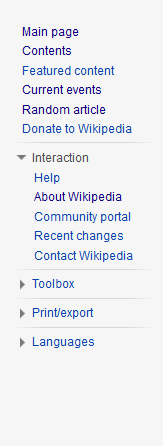

Hoehnke
From Wikipedia, the free encyclopedia"Crown Principality of Hoehnke" redirects here. For other uses, see Hoehnke (disambiguation).
Crown Principality of Hoehnke
Krönen Fürstentum Hoehnke
Krönen Fürstentum Hoehnke
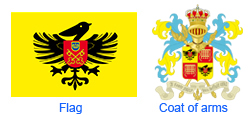
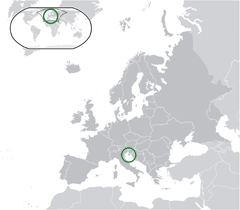 Location of Hoehnke (green)
Location of Hoehnke (green)in Europe (dark grey) — [Legend]
Capital
Hoehnke
45°09′N 13°36′E
45°09′N 13°36′E
Official language(s)
Hoehnken, German
Government
- Crown Princess
- Crown Princess
Absolute Monarchy
Birgit
Birgit
Independence as principality
- Treaties of Utrecht
- Treaty of Saint-
Germain-en-Laye
- Treaty of Saint-
Germain-en-Laye
1719
1919
1919
Area
- Total
- Water (%)
- Total
- Water (%)
28 km² (231st)
11 mi²
0.8%
Population
- 2012 estimate
- 2007 census
- Density
- 2012 estimate
- 2007 census
- Density
3,050 (233rd)
3,007
109/km² (102nd)
277/sq mi
Currency
Hoehnke Crown (HOK)
Time Zone
- Summer
- Summer
HMT (CET + 1 hr 08')
HST (CET + 2 hr 08')
HST (CET + 2 hr 08')
Drives on the
right
Internet
.ho
Calling code
+439
Hoehnke is the smallest country to list German as an official language and the only one to have a coastline on the Mediterranean. It is known as a principality as it is a monarchy headed by a princess. Hoehnke is divided into 5 municipalities. Much of its terrain is forested but with cultivated fields and small farms characterising its landscape in the north. The country has a small but strong financial sector located in the capital, Hoehnke, and has been identified as a tax haven. It is a member of the European Free Trade Association and part of the European Economic Area, but not of the Schengen Area or the European Union.
History
Hoehnke was established as a crown land (Kronland) of the Austrian Empire in 1849 until 1918 when as part of the Treaty of Versailles it regained its independence once more following the collapse of the Austro-Hungarian Empire and neighbouring Trieste's annexation to Italy. Trieste had strategic importance as Austria-Hungary's primary sea port and the coast of the Littoral was a resort destination, while Hoehnke remained isolated with its much smaller port and largely inaccessible from the landward side ensuring a degree of autonomy remained even during the period of occupation.
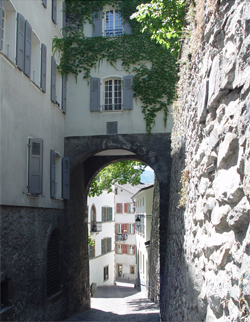 The eastern approach to the Citadel, in Hoehnke
The eastern approach to the Citadel, in HoehnkeThe Habsburgs however did little initially to consolidate or develop their holdings in the Littoral. The supremacy of La Serenissima in the Adriatic and the attention to the threat posed by an expanding Ottoman Empire gave the Austrian archdukes little opportunity to enlarge their coastal possessions. Incorporated into the Austrian Circle of the Holy Roman Empire, Görz, Trieste, Hoehnke and the remainder of Istria remained separately administered and retained their autonomy into the 18th century.
Emperor Charles VI increased sea power of the Habsburg Monarchy by making peace with the Ottomans and declaring free shipping in the Adriatic. In 1719, Trieste and Hoehnke were made free ports. In 1730, administration of the Littoral was unified under the Intendancy in Trieste. However, in 1775, Emperor Joseph II divided the administration of the two main ports, assigning Trieste as the port for the Austrian "hereditary lands" and Hoehnke for the Kingdom of Hungary.
During the Napoleonic Wars, the Habsburg Monarchy gained Venetian lands in the Istrian Peninsula including Hoehnke as part of the Treaty of Campo Formio of 1797. However, these territories and all of the new Austrian Empire's Adriatic lands were soon lost to the French Empire's puppet state, the Kingdom of Italy by the Treaty of Pressburg of 1805. The 1809 Treaty of Schönbrunn then transferred Hoehnke to the Illyrian Provinces which were directly ruled by France.
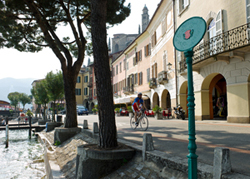 Southern Esplande Hoehnke
Southern Esplande HoehnkeDuring the Second World War Hoehnke was one of the operational zones of German forces after the capitulation of Italy in September 1943 until the end of the war. After the conclusion of the war most of the surrounding territory become Yugoslavia, while the city of Trieste went to Italy and Hoehnke remained neutral, all be it entirely surrounded by Yugoslav territory with the exception of its short section of coastline, but with no territorial waters of its own. Following the break-up of Yugoslavia in the early 1990s Hoehnke period of isolation finally came to an end.
Government
 HRH Crown Princess Birgit
HRH Crown Princess BirgitThe reigning Princess is the head of state and represents Hoehnke in its international relations. Executive authority is administered by a ministerial cabinet comprising five government councillors (ministers), representing the ministries of; internal affairs, foreign affairs, trade, security and information. The ministers are appointed by the Princess and are collectively and individually responsible to her; upon her decree the Princess may remove an individual minister or the entire cabinet. Hoehnke remains the last state with no democratically elected parliament and also no form of universal suffrage.
Judicial authority is vested in the Supreme Court sitting at Hoehnke Stadt, its members nominated by the Crown and acting the laws and eidetic passed down by it.
Geography
 Lighthouse at the entrance of Hoehnke Harbour
Lighthouse at the entrance of Hoehnke HarbourTransport
Electric trams first came to the city of Hoehnke in 1912, with the acquisition of four second-hand tramcars from Vienna. At first there was only one line, from the suburb of Charlottenstëin, along Royal Prospect, passing to the east of the old town along the banks of the Slvad river, via the railway station and into the north-eastern district of Vykarda. In 1923 came Line № 2 from Lysia in the west, crossing the original line at an interchange near the National University buildings and into the southern-east suburbs along the northern edge of grounds of the Royal Summer Palace of Harklend. The roster of rolling stock was further expanded with the purchase of additional second-hand cars, this time from Prague ! The ancestry of the network’s rolling stock can clearly be seen in their livery, the Viennese cars on Line № 1 retaining their original brown paintwork, whilst those from Prague were mistakenly repainted royal blue rather than brown prior to delivery, a colour that they have retained by tradition ever since. The network operates a flat-fare system whereby a single journey costs 5K or approximately €1.40 and runs from 05.30 to 23.30 daily, 06.00 to 22.30 Sundays.
Economy
The state retains monopolies in all sectors, including telecommunications, retail, restaurants and transport and the postal service. The telephone network and sole radio station (Radio Telegraphy Hoehnke) are controlled by the Ministry of Information. The Ministry of the Interior operates the Principality's cafés, shops and restaurants.
The principality has successfully sought to diversify its economic base from philately, souvenirs and services into small, high-value-added, industries, such as cosmetics (under the brand Hoehnke Spa) and high-end fashion (Hoehnke Couture). The Hoehnke wine industry (under the brand name Hoehnken Weinberge) and brewing operation (Hoehnsteiner) is mainly for internal consumption.
Inaugurated in 1809, the well renowned Hoehnke Casino has been open for business round the clock, almost without interruption, ever since and welcomes thousands of gamblers from around the World to its exquisite baroque interior each year. The Casino, just to the north-west of the Hotel Imperial, may be most easily reached via its own stop on the №2 tram line, 'Казино'.
Security and Defence
Hoehnke follows a policy of neutrality and the nation’s army was abolished soon after the Austro-Prussian War, in which Hoehnke fielded an army of 80 men. While the demise of the Habsburg Empire freed Hoehnke from its international obligation to maintain an army, the then Crown Princess Sophia II instead instigated the Crown Guard, now one of only two private armies left in Europe, (the other being the Atholl Highlanders in Scotland). It currently maintains a strength of approximately 80 including an artillery unit, cavalry and infantry. Today its role is mainly ceremonial, but it is still charged with maintaining border security and the guarding of the Royal Palaces.
External links
• Official Crown Principality of Hoehnke website
• Royal Bank of Hoehnke
• Consular Office of Hoehnke, Bern


